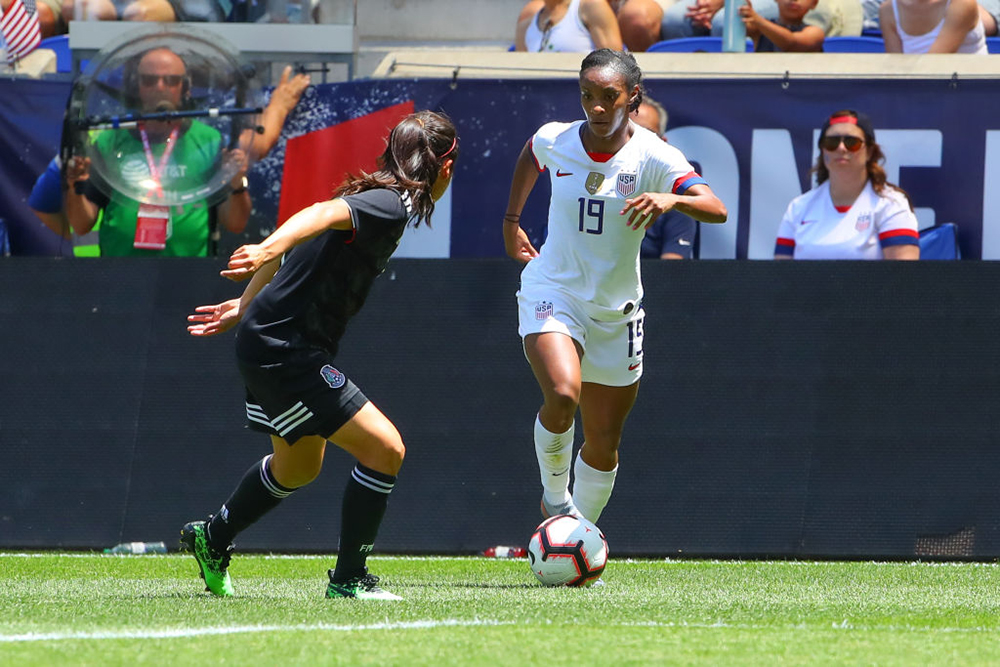When it comes to iconic U.S. soccer teams, none tops the 1999 U.S. Women’s National Team. That squad is still so special today because its tournament run, culminating in a shootout victory over China before a huge crowd in Pasadena’s Rose Bowl, created a wave of change that led to more funding and resources for the women’s national team, as well as the founding of the first North American women’s soccer league.
When asked about the ‘99ers, as they’re known, at U.S. Soccer media day last month, forward Alex Morgan simply replied: “Now it’s our turn to make our mark.”
Indeed, twenty years after the 1999 tournament, the U.S. Women’s National Team is again seeking both a World Cup title and a massive shift in the perception of a woman’s worth in sports. Moreover, women athletes in other sports are hoping Team USA’s success will mean more power for them in their own labor organizing efforts.
Get Talk Poverty In Your Inbox
In March, U.S. players filed a class action lawsuit against the United States Soccer Federation (USSF) for gender-based discrimination. The lawsuit highlights inequities in travel conditions, promotion of games, staffing, and support and development. All are persistent despite improvements that came with a 2017 collective bargaining agreement and after a 2016 lawsuit.
The latest lawsuit states that the U.S. women were offered $40,000 less for making the 2015 World Cup roster than men were offered for making a 2014 roster. That pay gap stretched to $53,750 by 2018. The lawsuit also states that the women’s team made 38 percent of the compensation of the men’s team from March 19, 2013 to December 31, 2016, despite bringing in more revenue than the men’s team in 2016.
The revenue surplus on the women’s side is impressive, but does represent an outlier, and is greatly driven by the 2015 World Cup and subsequent victory tour. Knowing that, players were willing to have compensation increase only in years they outearned the men’s team.
U.S. Soccer denied these claims in their defendant’s answers and affirmative defenses filed May 6, 2019, stating “the current CBA provides for player compensation that increases based on increased viewership, attendance and sponsorship revenue, in each case over and above their guaranteed salary and other benefits.” So 28 players, including 22 on the 2019 World Cup roster, are moving forward with their lawsuit.
When comparing the list of accomplishments for the women’s national team, which includes three World Cup titles, four Olympic gold medals, and being ranked number one in the world for 10 of the last 11 years, to that the men’s national team, which has no World Cup titles or Olympic medals and hasn’t even qualified for the Olympics since 1988, one can hardly say the pay scale is based on merit.
Other female professional athletes see the soccer team’s argument as air-tight. They also believe a win in court for the U.S. team will mean a win for them too.
“When you look at the women’s national soccer team, they are better than the men, they do generate more money, they do pack the stands,” said four-year WNBA veteran Imani McGee Stafford, a center for the Dallas Wings. “They check all of those boxes and the only conversation as to why they don’t get paid like the men is because they are women.”
WNBA players recently opted out of their collective bargaining agreement and hope to negotiate with the NBA for better travel regulations, higher salaries, and higher revenue splits. Sports economist David Berri noted the current agreement with the WNBA and the NBA, its overseer, offers players roughly 25 percent of WNBA revenue, while NBA players own a 50 percent split of revenue. Additionally, NBA player contracts protect players from playing within 24 hours of travel between time zones. WNBA contracts do not.
If the women’s soccer team is the standard for WNBA players, the 23-year-old women’s pro basketball league is the standard women’s hockey players hope to achieve, as professional women’s hockey has struggled for years to stay afloat. In the 2017 #BeBoldForChange boycott and the current #ForTheGame movement pushing for what they deem a viable league, women’s hockey players seek a North American league that can pay a livable wage and meet professional standards.
Women’s hockey players recently organized the Professional Women’s Hockey Players Association, which consists of more than 200 hockey players, including all of Team Canada and Team USA, who say they will not sign contracts to play in North America. The #ForTheGame movement made waves on social media on May 2, one day after the closure of the Canadian Women’s Hockey League (CWHL), which left the National Women’s Hockey League (NWHL) as the only professional league left standing in North America.
“We are fortunate to be ambassadors of this beautiful game, and it is our responsibility to make sure the next generation of players have more opportunities than we had,” said USA Hockey forward and 2018 Olympic gold medalist Kendall Coyne Schofield in the PWHPA release. “It’s time to stand together and work to create a viable league that will allow us to enjoy the benefits of our hard work.” Coyne Schofield earned $7,000 playing for the 2019 NWHL champion Minnesota Whitecaps. Canadian 2018 silver medalist Sarah Nurse earned $2,000 playing for the Toronto Furies in the CWHL.
But is the fact that other women athletes are watching the women’s soccer team’s fight so closely added pressure or motivation?
“I think it’s both,” said midfielder Morgan Brian. “Seeing those other women’s professional teams follow along with our journey, I think it inspired us to continue to keep the conversation going and to push for more … that’s something that we’ve always had in our DNA and want to be a part of us. We’re not only great on the field and pushing along the women’s game, but we’re also pushing along the women in this world.”
– Ashlyn Harris
Goalkeeper Ashlyn Harris said that because she is preparing for a World Cup, she has a platform to speak about equality and a duty to use it, especially as she looks towards the end of her career.
“I’ve dedicated my entire life to my craft,” said Harris. “I have not been financially rewarded for what I’ve given and the success I’ve reached. So why do we speak up? Because I don’t want the future to have to worry about what I have to worry about in a few years, and that’s starting this life all over again at 35.”
After the World Cup, Harris and her World Cup teammates will continue their fight with U.S. Soccer. It is important to note that, while the 2019 lawsuit specifically seeks damages for national team players, the team still knows there is work to do in the USSF-owned National Women’s Soccer League.
Since 2016, the national team has found ways to incorporate the NWSL into its fight for gender equality in soccer, as players in that league who don’t play for their respective national teams don’t make a livable wage, and some NWSL teams even lack proper training conditions.
Crystal Dunn, who will be playing in her first World Cup, returned to the NWSL after being one of the final cuts from the 2015 World Cup roster. “World Cup years, I think are incredible. What [playing in NWSL] did for me was it allowed me to regroup and reset,” said Dunn. “That’s basically what really was important for me in 2015, was having the league to be able to take my mind off over everything else.”
The NWSL did raise the overall salary cap per team to $421,500 for the 2019 season. The increased salary cap brings the league minimum salary to $16,538 and the league max salary to $46,200, according to a January league release. The league also increased the housing allowance for each franchise, perhaps in light of controversy endured by New Jersey last year. Sky Blue FC came under massive heat when players began talking about the subpar conditions they faced for years. Training facilities with no running water, no showers at their home field facilities, and deplorable housing were just a few things they brought to light.
For all of these reasons and more, the fight off the pitch is important to the women’s national team. So too is playing to up their standards in France. The goal: World Cup champion or bust.











